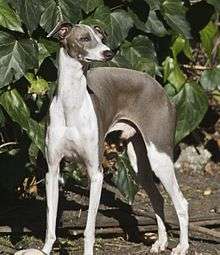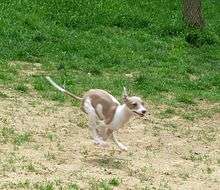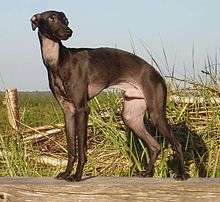Italian Greyhound
 | ||||||||||||||||||||||||||
| Other names |
Italian: Piccolo Levriero Italiano French: Levrette d'Italie German: Italienisches Windspiel Spanish: Galgo italiano | |||||||||||||||||||||||||
|---|---|---|---|---|---|---|---|---|---|---|---|---|---|---|---|---|---|---|---|---|---|---|---|---|---|---|
| ||||||||||||||||||||||||||
| Domestic dog (Canis lupus familiaris) | ||||||||||||||||||||||||||
The Italian Greyhound (in Italian: Piccolo Levriero Italiano) is a small breed of dog of the sight hound type, sometimes called an "I.G." or an "Iggy".[1]
Description
The Italian Greyhound is the smallest[2] of the sighthounds, typically weighing about 8 to 15 lb (3.6 to 6.8 kg) and standing about 13 to 15 inches (33 to 38 cm) tall at the withers.[3] Though they are in the "toy" group based on their weight, they are larger than other dogs in the category due to their slender bodies.
The Italian Greyhound's chest is deep, with a tucked up abdomen, long slender legs and a long neck that tapers down to a small head. The face is long and pointed, like a full sized greyhound. Overall, they look like "miniature" Greyhounds. Though many Italian Greyhound owners dispute the use of the term "miniature Greyhound" in reference to the breed itself, by definition of the American Kennel Club[4] they are true genetic greyhounds, with a bloodline extending back over 2,000 years. Their current small stature is a function of selective breeding. Their gait is distinctive and should be high stepping and free, rather like that of a horse. They are able to run at top speed with a double suspension gallop,[5] and can achieve a top speed of up to 25 miles per hour (40 km/h).
The color of the coat is a subject of much discussion. For The Kennel Club (UK), the American Kennel Club, and the Australian National Kennel Council, parti colored Italian Greyhounds are accepted, while the Fédération Cynologique Internationale standard for international shows allows white only on the chest and feet.[6]
The modern Italian Greyhound's appearance is a result of breeders throughout Europe, particularly Austrian, German, Italian, French and British, making great contributions to the forming of this breed. The Italian Greyhound should resemble a small Greyhound, or rather a Sloughi, though they are in appearance more elegant and graceful.
Temperament

The Italian Greyhound makes a good companion dog and enjoys the company of people. However, the breed's slim build and short coat make them somewhat fragile, and injury can result from rough or careless play with children. The breed is good with the elderly or a couple without any children for it prefers a quiet household but they are also generally fine with older children. They also are equally at home in the city or the country, although they tend to do best in spacious areas. They are fast, agile and athletic. Like any dog, daily exercise is a must for a happier, well-adjusted pet. Italian greyhounds love to run. The young dog is often particularly active, and this high level of activity may lead them to attempt ill-advised feats of athleticism that can result in injury. Due to their size, and in some lineages poor bone density, they are prone to broken legs. Italian Greyhounds make reasonably good watchdogs, as they bark at unfamiliar sounds. They may also bark at passers-by and other animals. However, they should not be considered "true" guard dogs as they are often aloof with strangers and easily spooked to run.
As gazehounds, Italian Greyhounds instinctively hunt by sight and have an extremely high predator drive. Owners of Italian Greyhounds should typically keep their dogs leashed at all times when not in an enclosed area to avoid the risk of even a well-behaved pet breaking away at high speed after a small animal. Like most sight hounds, because the Italian Greyhound's slender skull is near the same width as its neck, the use of a Martingale Collar is advised for walking. The collar tightens up when pulled while remaining comfortably slack when the dog is walking politely. This prevents the dog from backing out and escaping. Breakaway collars are advised for identification, because this active and acrobatic breed could easily injure themselves when put in a collar they cannot escape from, and this leads to possible neck injuries and strangling.
Some Italian Greyhounds enjoy dog agility. The breed's lithe body and its love of action provide potential to do well at this sport, although not many Italian Greyhounds participate, and their natural inclination is for straight-out racing rather than for working tightly as a team with a handler on a technical course.
Lure coursing is well-fitted to the Italian Greyhound, and they seem to enjoy it tremendously. Although the Italian Greyhound is a very fast dog, it is not as well suited to racing as its larger cousin. Regardless, many Italian Greyhounds participate in amateur straight-track and oval-track racing.
Grooming

Dogs of this breed have an extremely short and almost odorless coat that requires little more than an occasional bath about once a month (though many veterinarians suggest that even bathing one per month is too frequent for this breed), but a wipe-down with a damp cloth is recommended after walks as seeds, burrs and floating dust in the air can get into the coat and irritate the skin. This breed sheds medium to little hair.
Health
The Italian Greyhound has a median lifespan of 13.5 in a 2004 UK Kennel Club survey.[7] A 1993 US breed club survey gives an average lifespan of 9 years but more than a quarter of the dogs had "accidents" recorded as cause of death. When this dog is still a puppy its bones are weak and feeble. Because of this, owner should always make sure to keep their Italian Greyhounds safely confined in a crate or room without any furniture as not to risk the dog jumping off a bed or couch resulting in broken legs and such.[8]
Health problems that can be found in the breed:[9]
- Epilepsy
- Legg-Perthes disease (degeneration of the hip)
- Patellar Luxation (slipped stifles)
- von Willebrand disease (vWD) (Bleeding disorder)
- Progressive retinal atrophy (PRA)
- Color dilution alopecia (hair loss in dilute pigmented dogs, i.e.: blues, blue fawns, etc.)
- Leg Breaks (most common under the age of 2)
- Cataracts
- Vitreous degeneration
- Liver shunts
- Autoimmune hemolytic anemia
- Periodontal disease, gum recession, early tooth loss, bad tooth enamel
- Hypothyroidism, Autoimmune Thyroid Disease (Hashimoto's disease)
Their scissor-bite and thin jaw bones make them susceptible to periodontal disease, which can be avoided with good dental care. Daily brushing has been shown to be very beneficial as well as regular dental cleanings from the vet.
Responsible breeders will routinely check their dogs for the onset of various inherited disorders, these commonly include (but are not limited to): CERF examinations on eyes, OFA patellar examinations, OFA thyroid function panels, von Willebrand's factor, OFA hip and Legg-Perthes disease x-rays, and others. In research by the Ortheopedic Foundation for Animals, the Italian Greyhound was found to be the least affected by hip dysplasia out of 157 breeds. Tests were conducted on 169 individual Italian Greyhounds, of which none were found to have hip dysplasia and 59.2% scored excellent on their hip evaluations.[10]
History
.jpg)
The name of the breed is a reference to the breed's popularity in Renaissance Italy. Mummified dogs very similar to the Italian Greyhound (or small Greyhounds) have been found in Egypt, and pictorials of small Greyhounds have been found in Pompeii, and they were probably the only accepted companion-dog there. Dogs similar to Italian Greyhounds are recorded as having been seen around Emperor Nero's court in Rome in the first century AD.[11]
The breed is believed to have originated more than 2,000 years ago in the countries now known as Greece and Turkey. This belief is based on the depiction of miniature greyhounds in the early decorative arts of these countries and on the archaeological discovery of small greyhound skeletons. By the Middle Ages, the breed had become distributed throughout Southern Europe and was later a favorite of the Italians of the sixteenth century, among whom miniature dogs were in great demand. Sadly, though, 'designer' breeders tried, and failed, to make the breed even smaller by crossbreeding it with other breeds of dogs. This only led to mutations with deformed skulls, bulging eyes and dental problems. The original Italian Greyhound had almost disappeared when groups of breeders got together and managed to return the breed to normal. From this period onward the history of the breed can be fairly well traced as it spread through Europe, arriving in England in the seventeenth century.
The grace of the breed has prompted several artists to include the dogs in paintings, among others Velázquez, Pisanello, and Giotto.
The breed has been popular with royalty. Among the royal aficionados are Mary, Queen of Scots, Queen Anne, Queen Victoria, Catherine the Great, Frederick the Great and Maud, Queen of Norway.
Popular culture
The breed is also represented in the film Good Boy!. Nelly is an Italian Greyhound played by "Motif" and "Imp".[12]
See also
References
- ↑ Barber, Lillian S., The New Complete Italian Greyhound, p. 5 (1993, Italian Greyhound Productions) ISBN 0-9611986-2-1
- ↑ "Italian Greyhound Did You Know?". American Kennel Club. Retrieved 13 April 2014.
- ↑ "Italian Greyhound". American Kennel Club. Retrieved 13 April 2014.
- ↑ "History". American Kennel Club. Retrieved 13 April 2014.
- ↑ "Italian Greyhound (video)". American Kennel Club. Retrieved 13 April 2014.
- ↑ "Italian Greyhound standard". Fédération Cynologique Internationale. Retrieved 13 April 2014.
- ↑ "Breed Longevity Data".
- ↑ "Study Citations".
- ↑ Dickinson, Teri. "Health concerns". Italian Greyhound Club of America. Archived from the original on 13 April 2014. Retrieved 13 April 2014.
- ↑ "Hip Dysplasia Statistics: Hip Dysplasia by Breed". Ortheopedic Foundation for Animals. Archived from the original on 2010-02-10. Retrieved 2010-02-10.
- ↑ Stonehenge (1866). The Dogs of the British Islands. Horace Cox, London. p. 138.
- ↑ "Good Boy! Full cast and crew". Internet Movie Database. Retrieved 26 April 2007.
External links
| Wikimedia Commons has media related to Italian Greyhound. |